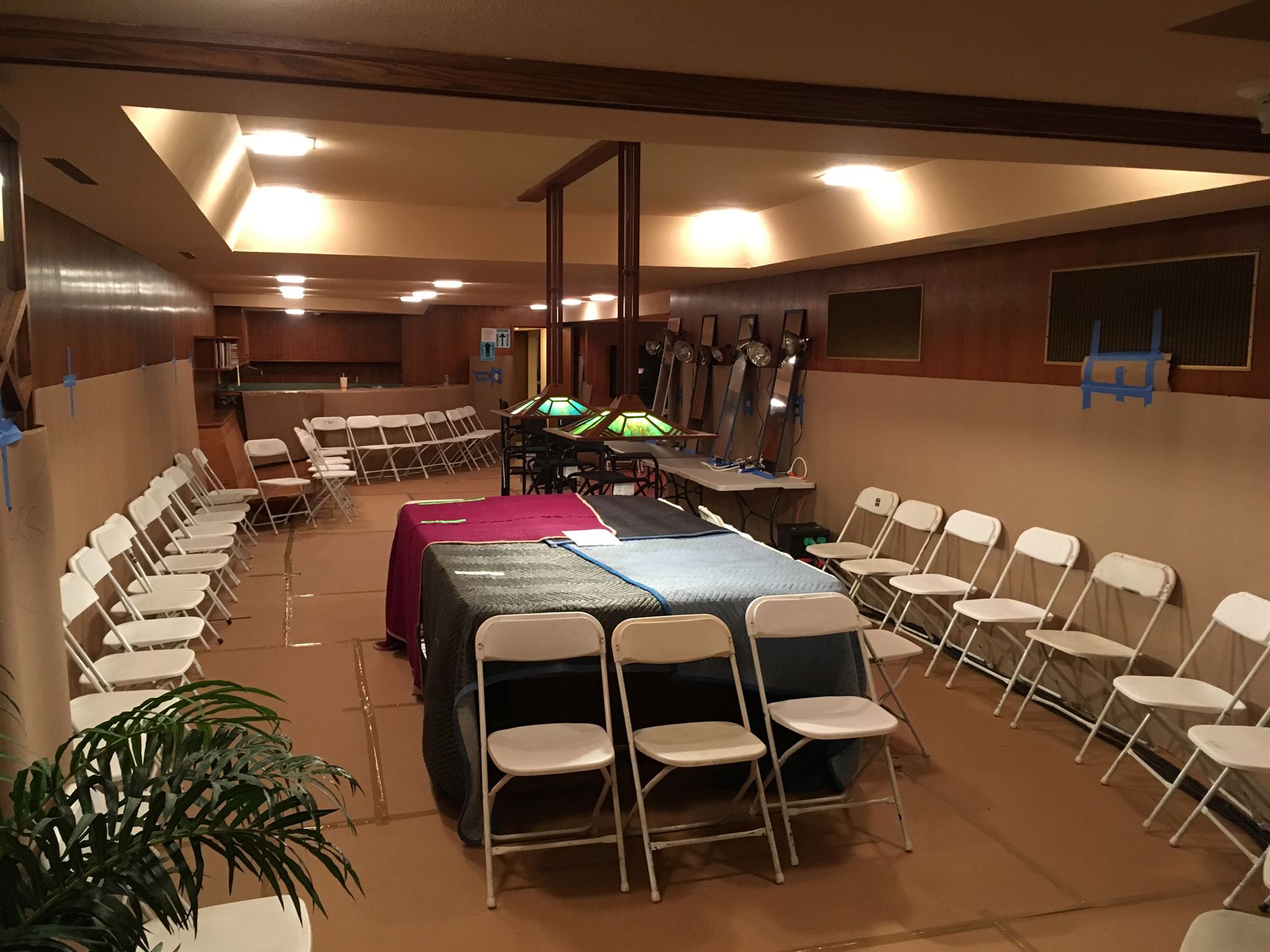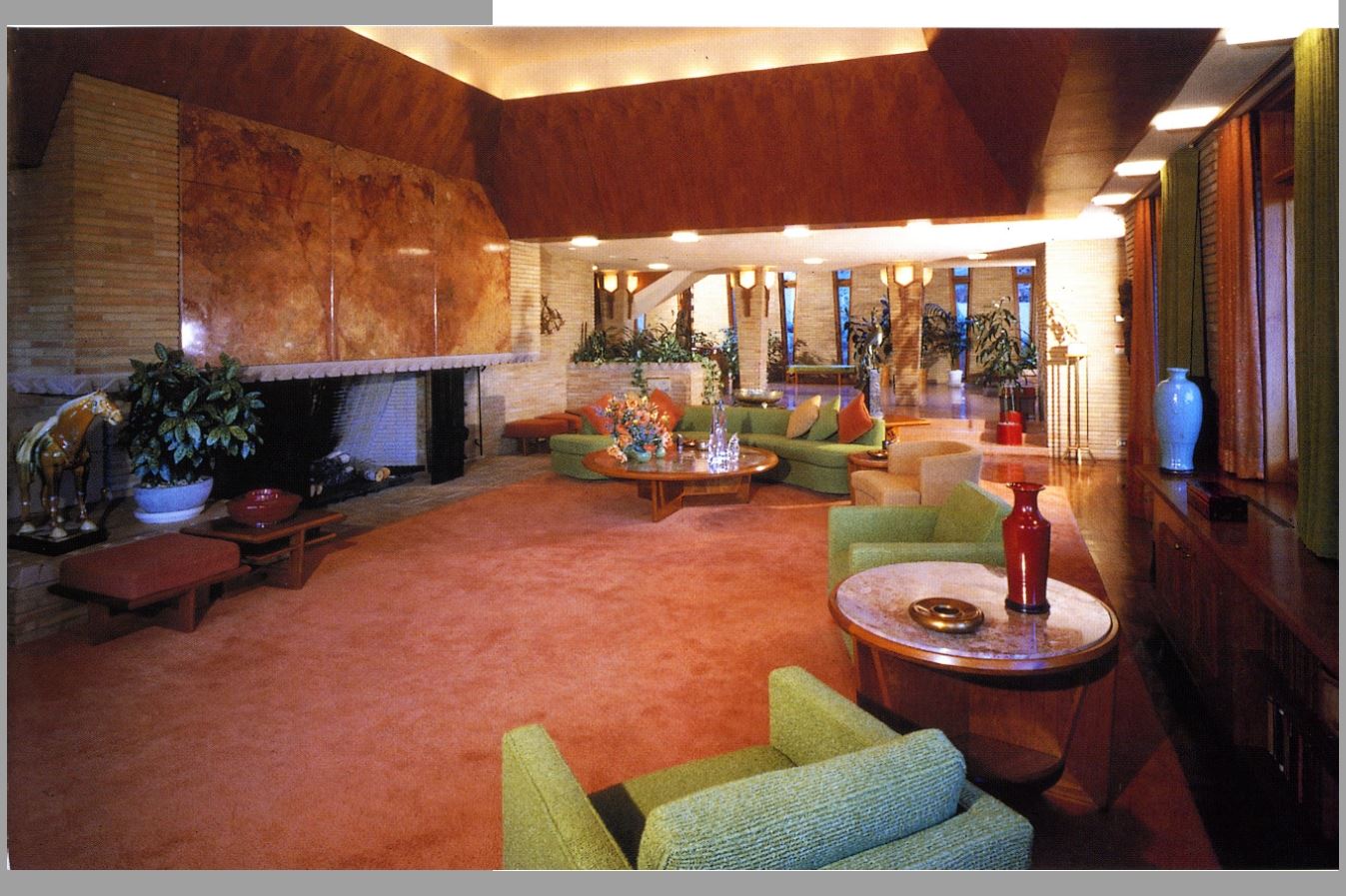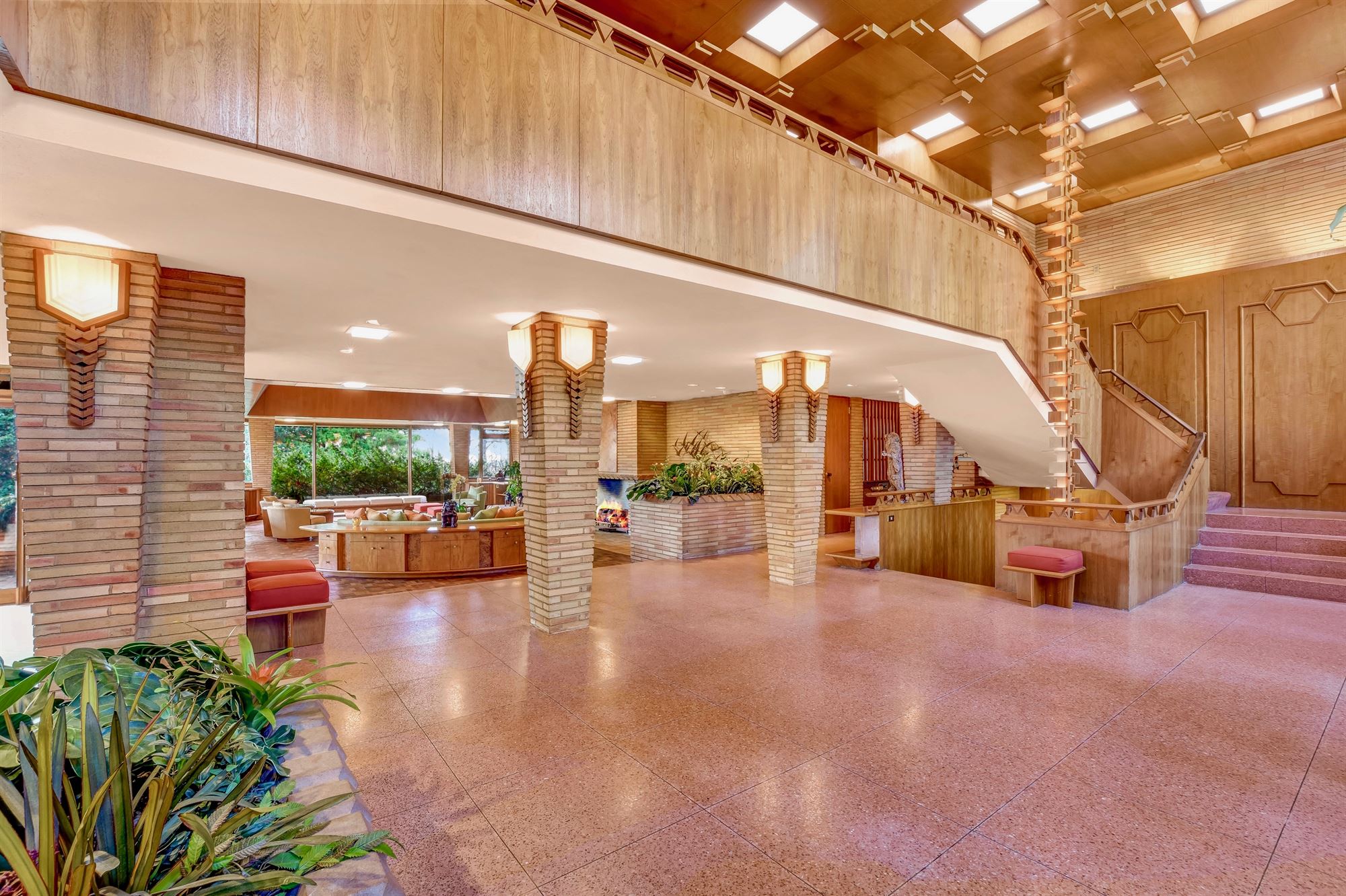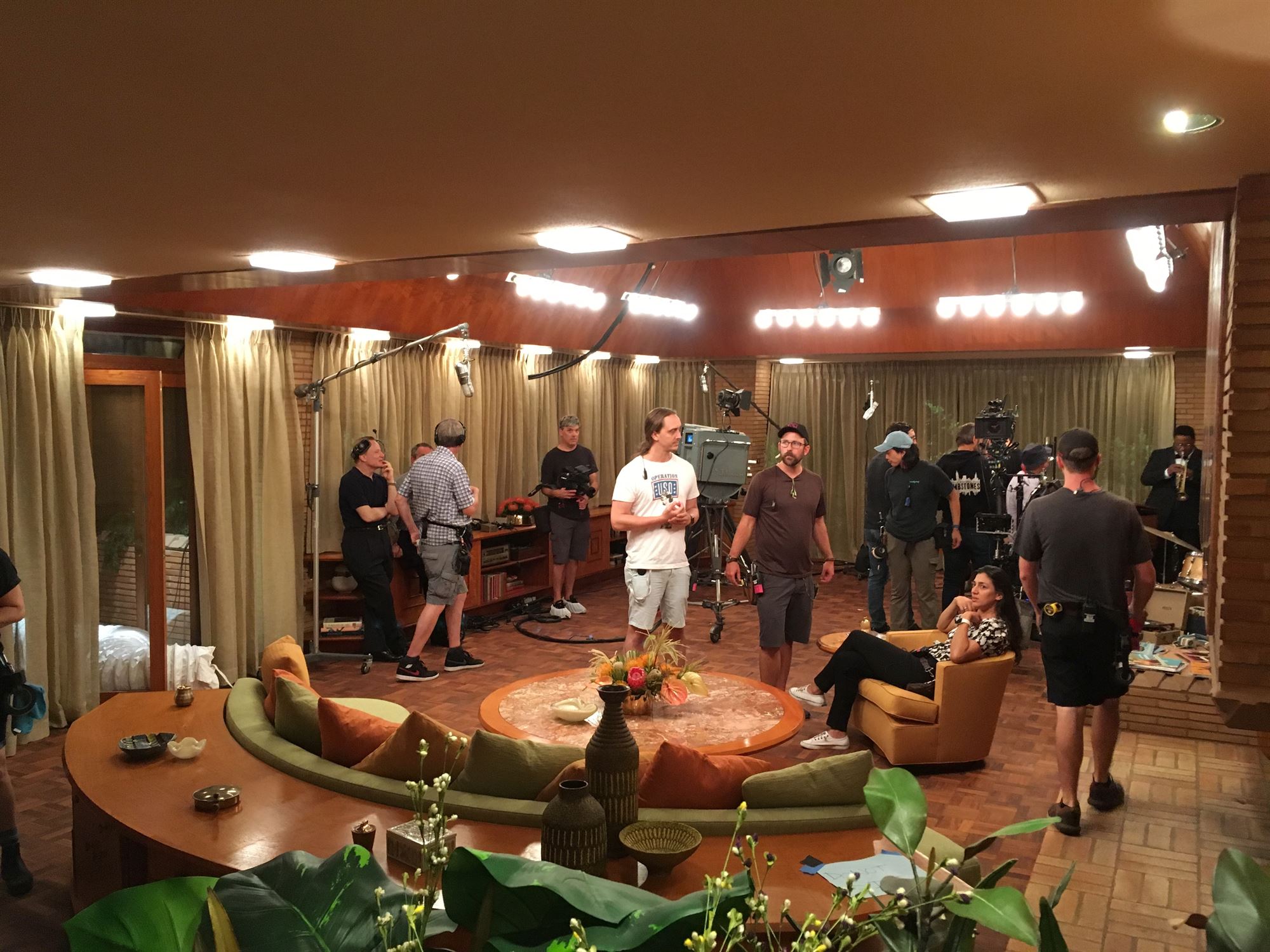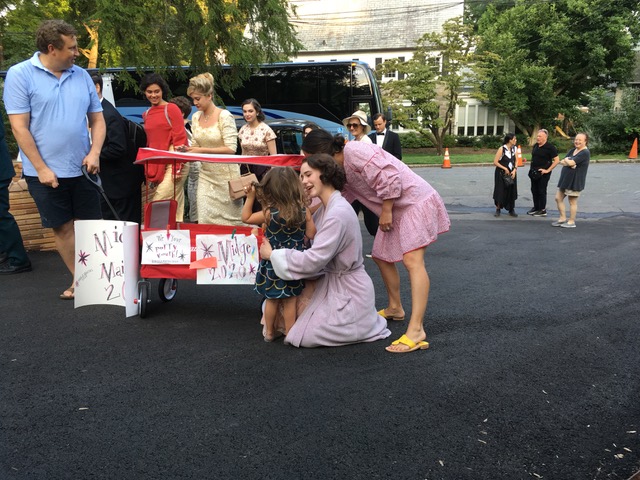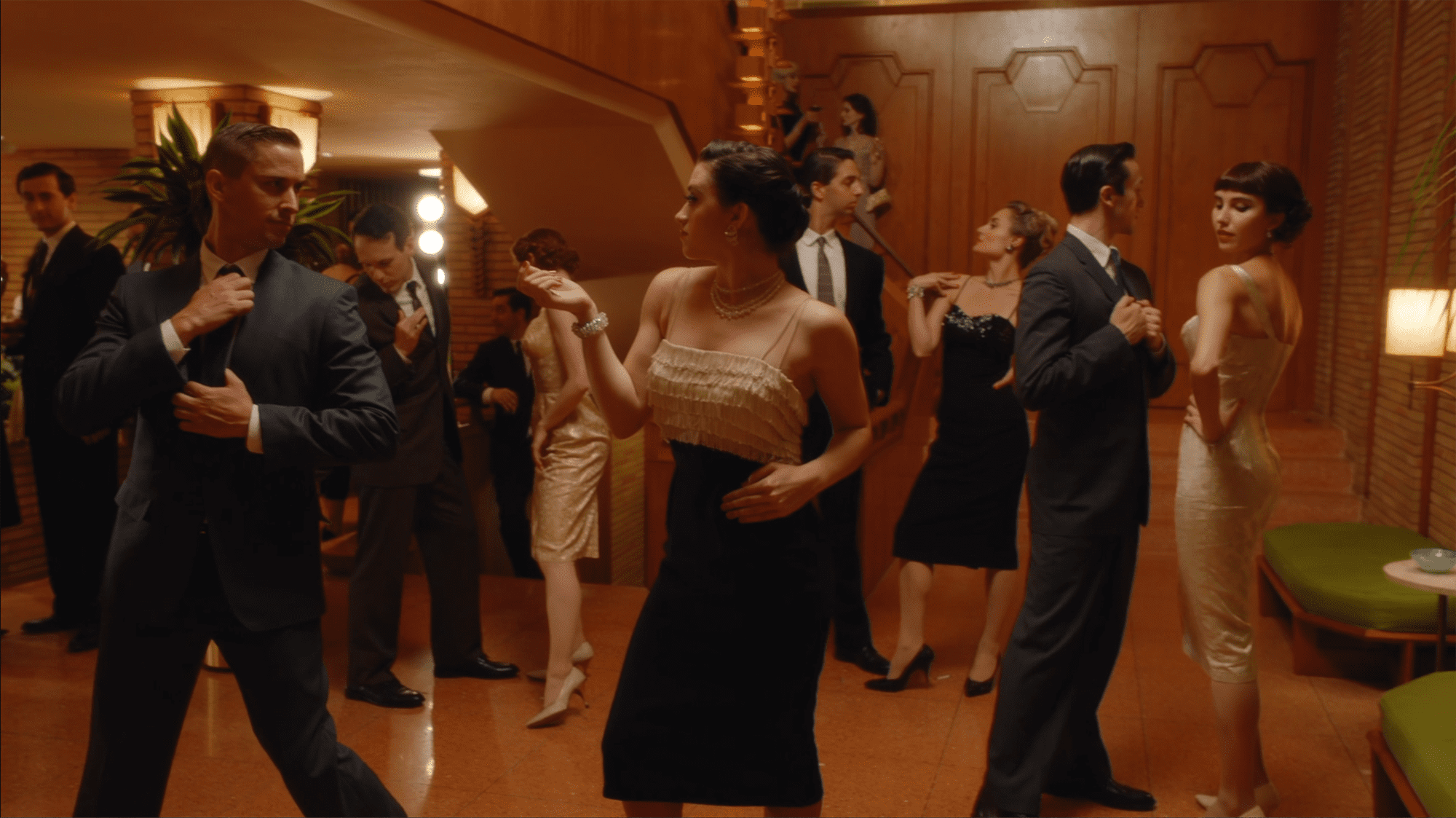
Miami After Dark set from Marvelous Mrs. Maisel, Season 3, Episode 5, at 15 Tower Drive, Maplewood, NJ.
Season 3 of Amazon’s Marvelous Mrs. Maisel debuted on December 6 and by now all of SOMA has had plenty of time to ponder where those Maplewood interiors make an appearance.
Wonder no more. We have the answer.
Interiors shot this past summer at the Kessler House at 15 Tower Drive — a Frank Lloyd Wright-inspired home in the Upper Wyoming neighborhood — appeared in Season 3, Episode 5. That’s the episode where Lenny Bruce (played by the sweetly sexy Luke Kirby) and Midge Maisel (the luminous Rachel Brosnahan) spend a night on the town in Miami. Yep, a mid-century home in a New Jersey suburb is used as a stand-in for the set of a fictional Playboy’s Penthouse-esque TV show called Miami After Dark.
But it’s not just any mid-century New Jersey suburban home.
“15 Tower Drive is a very special and unique Maplewood property,” explains Ben Garrison of Coldwell Banker. Garrison is the listing agent for the property on behalf of sellers Kenneth and Barbara McLaughlin.
(Find out more about this historic home here: 15TowerDr.com. Take a video tour of the home below.)
But back to Mrs. Maisel: Owner Ken McLaughlin generously shared reams of details about the shoot (including a candid shot of Brosnahan greeting fans) and we lapped it up.
Here are McLaughlin’s observations:
I like to be super clear about the connection between the Kessler House and Frank Lloyd Wright. John Rattenbury of Taliesin Architects began designing the house five years after Wright died. Taliesin Architects was the firm that continued Wright’s practice as a subsidiary of the Frank Lloyd Wright Foundation. Rattenbury apprenticed with Wright and never left. He was a right-hand man of Wright’s when Wright died in 1959, and he was a leading architect at Taliesin Architects for about 45 years.
Barb and I thoroughly enjoyed our experience with the Mrs. Maisel shoot at our house. Our neighbors got all excited, too. And the feedback from the location manager (Amanda Burbank) was that Amy Sherman-Palladino (creator of the show and writer and director of the episode) thinks the shoot was their best location of the season. So everyone’s happy.
Barb was away on business for a full week. She left the day before the shoot, and the house was back together when she returned home. That explains why Barb is missing from most of the action below.
Background
Season 3, episode 5: “It’s Comedy or Cabbage”. The scene runs 6.5 minutes and has a cast of 75 actors and a crew of 75. Our living room and entrance hall was the set of “Miami After Dark,” a live late night talk show modeled after Hugh Hefner’s “Playboy’s Penthouse,” which premiered in October 1959.
(We have to keep track of three shows: The Marvelous Mrs. Maisel, “Miami After Dark” as the show within Mrs. Maisel, and “Playboy’s Penthouse,” the real show from six decades ago.)
Lenny Bruce, as well as Ella Fitzgerald and Nat King Cole, was on the first episode of Hefner’s show. That show fits the talk show format with Hefner talking to celebrities and the celebrities performing. But the show’s setting is a cocktail party in a penthouse, and Hefner walks around meeting his guests. In that first episode, song writer Cy Coleman introduces a new song “The Best Is Yet to Come,” which Frank Sinatra later recorded and made famous. In “Miami After Dark,” Jem Moreland plays a new song that he thinks Frank Sinatra will record. The scene also has two girls browsing through record albums; in “Playboy’s Penthouse,” the girls were Playboy playmates. And our dining room was transformed into the off-camera area (control room?) where Midge sits, eats donuts, and watches the TV monitors before Lenny pulls her into the live show.
Since the Mrs. Maisel folks were recreating a late night show, and shooting would start in the afternoon, they needed blackout curtains to cover the floor-to-ceiling windows that wrap around our dining and living rooms, and the 16’ tall windows and 20 skylights in the entrance hall. They placed tropical plants between the windows and the black-out curtains, and lights cast shadows of the plants onto the window sheers—a subtle touch to convince us that we’re in Miami.
The crew took four days to prep, one very long day to shoot, and two days to pack up and move out. Three additional days were tacked on to restore the teak parquet floors and the terrazzo floor and to clean the carpet on the entrance stairs.
Temple Sharey Tefilo-Israel in South Orange was the base camp for hair, make up, and wardrobe, as well holding for trucks and parking for cast and crew. Shuttle buses and one motor coach shuttled the cast and crew to our house, the Kessler House on Tower Drive in Maplewood. Dinner was catered at the Oheb Shalom Congregaton in South Orange.
The crew was incredibly careful in the days leading up to the shoot. No shoes, no food, no drinks other than water, and no smoking in the house. (The location assistant also has a rule of no cursing at her locations.) Floors and walls were fully protected. Things were different once the cast arrived. The most important difference was smoking. Since the scene is a glamorous cocktail party in 1960, smoking and ash trays were everywhere. But the two didn’t meet. In particular, the background actors didn’t use the ashtrays because moving to an ash tray would distract from the scene. So hour after hour of ashes from herbal cigarettes dropped on the floors and were tracked around. (Hence the three additional days.)
They filmed the scene in one long take. Amy would call “Action”, and 7-8 minutes later “Cut”. Over the 7-8 minutes, with 75 actors moving all over, the person operating the main, handheld camera moved through the three rooms and negotiated the steps that connect the entrance hall to the living room—down the steps, up the steps, then down the steps again. In the hours that they repeated the scene, no one missed a line. I didn’t see one blooper. Every take seemed perfect to me.
Production Design
I thoroughly enjoyed working with the Emmy-award winning production designer Bill Groom and the set decorators Ellen Christiansen and Susan Kaufman. They were looking for a large mid-century modern space to host the scene, and they fell in love with the beautiful detail of the Kessler House. They originally planned to remove our furniture and decorate the set with mid-century furniture and carpets. When I showed Bill, Ellen, and Susan vintage photos of the living room, they loved how the furnishings’ fall colors (greens, golds, oranges) complemented the teak panels, the teak parquet floor, and the Italian marble fireplace.
When the director (Amy Sherman-Palladino), producers, and all the department heads visited on the tech scout, Amy nixed the plan for carpet; she loved the floor. Since the floor under the carpet was darker than the exposed floor, they offered to restore the teak parquet floor in the living and dining rooms. The designers also loved our curved sofa, chairs, and ottomans by Harvey Probber, so they reupholstered these pieces, as well as hassocks and bench cushions, to restore the pieces to their original colors with mid-century fabrics. Barb and I had to agree to the fabrics, but that wasn’t a problem. They proposed the fabrics, and we said, “Perfect!”
Green Rooms and Tech Space
The master bedroom suite was set up as the green room for Rachel Brosnahan (Midge) and Luke Kirby (Lenny Bruce), the two stars in the scene. The green room for other principal actors was our guest bedroom, which has a separate seating area. Scores of background actors and the musicians waited in the game room on the lower level. In advance of the shoot, I had pictured myself chatting with the actors from behind the teak bar in the game room. No deal. The room, including the bar and pool table, was wrapped in cardboard, and the parquet floor was covered in cardboard, too. In this cardboard village, 60 background actors and musicians sat in white folding chairs.
The crew transformed our family room into the video village. In addition, the crew that handled the video feeds from the vintage “Miami After Dark” cameras worked in the breakfast area in the kitchen. The vintage cameras streamed hi-def color video to the equipment in the breakfast area where it was downgraded to black and white and sent to the vintage monitors in the control room of the “Miami After Dark” show. So when Midge looks at the the black-and-white monitors, that’s real footage from the vintage cameras; no green screens.
Featuring the Entrance Hall
When Amy arrived at 10 a.m. to see the decorated set for the first time, I watched her walk through the entrance hall, the living room, and the control room for the show within the show (our dining room). Then she walked back to the front door and looked at the Frank Lloyd Wright-style light fixture that hangs from the ceiling and extends down 25 feet into the game room below. Change of plans. Instead of using the entrance hall as background for the main shoot in the living room, she decided to shoot the show-within with the Hugh Hefner character walking down the steps from the upper level of the entrance hall. This shot shows off the room in general and the light fixture in particular. Wow! I was thrilled.
The new shot would include the doorway to the master bedroom suite, Rachel and Luke’s green room that day. I jumped to the rescue. Closing the door completely hides the master bedroom: the door becomes a teak panel that precisely matches 3 other teak panels on that wall. There isn’t even a knob on the outside.
So when the Amazon released season 3 on December 5, I cut to our scene anticipating a stunning shot of the Hugh Hefner character greeting his TV audience from the upper level of our entrance hall and descending the stairs around the custom light fixture—and with the custom door contributing some magic to the shot. When we get to that shot, the scene cuts to Midge watching the show-within on a small black-and-white TV. Oh, well.
No Green Screen
Shooting was in late July, and the fire blazed from 3:30 p.m. when shooting began until midnight. I expected them to green-screen the fire, but everything in Mrs. Maisel is authentic. During the shoot, an assistant cinematographer called me to one of the video monitors. “Ken, look at that fire. You can’t green screen that!”
With a fire roaring for hours in mid-day July in rooms filled with a cast and crew of over 100 people, our air conditioning system would have to be up to the task. Seven days before the shoot, however, I noticed that one of the six AC units that cools the house wasn’t working. And it was the unit that cools the entrance hall and the green room for the background actors. The AC unit wasn’t repairable. Could we replace it in time for Friday’s shoot? Nope. On that Saturday morning, I called the two HVAC companies that we work with and explained the dire situation: we’ll have a cast and crew of 150 people in the house for 19 hours on Friday. “We’re desperate! If you install the new system by Thursday, you will be the hero.” Within two hours (on Saturday), Air Group called back and reported that the owner of the company approved bumping scheduled work to the following week to help us out. No extra charge either. Happy to help. The new unit was installed two days before the shoot.
Midge’s Donuts
A caterer from Brooklyn cooked in our kitchen all day to create hors d’oeuvres for the “Miami After Dark” cocktail party. But the food was just for show. Also, when Lenny pulls Midge into the “Miami After Dark” show (i.e., the show within the show), she tosses two donuts over her shoulders. The caterer dipped the donuts into melted chocolate. Lots of donuts because they don’t reuse tossed donuts.
Neighbors
To get the permit from the township to shoot until 2am, the production team had to get approval from 30 homeowners in our neighborhood. The shoot would be Friday night, the shooting would be interior, our property is large and we’re well screened from the neighbors, and most of the trucks would be at the basecamp in South Orange. But there’s always some grumpy neighbor, right? The feedback from the production assistants who went door to door (sometimes in the evening and eventually one weekend to get the stragglers) was that “All your neighbors are great. Everyone’s excited.”
And the neighbors came out on the evening of the shoot. After the catered dinner at Oheb Shalom Congregation in South Orange, a motor coach and shuttle buses dropped off the cast and crew at the bottom of the driveway. Neighbors all decided that it was the perfect time to walk dogs; those without dogs realized the kids definitely needed some exercise right then. One group of neighbors positioned patio furniture along the property line to watch the actors and actresses stroll up the driveway while they (the neighbors, of course) sipped wine. And that’s when a couple arrived with their two little girls in a decorated wagon at the bottom of the driveway. Signs on the wagon read, “Midge 2020” and “Midge, We [heart] Your Potty Mouth.” Someone on the crew took a photo and called Rachel in her green room, and Rachel in dressing robe and slippers strode down the driveway to greet her young fans with hugs and to pose for photos. Luke was there too, but neither the girls nor the adults in the neighborhood were the least bit interested in him. Not while Rachel was there.
Shooting finished at midnight. The band played the big song (“Make Mine a Double”) 5 or 10 times to get the perfect recording, and the last truck rolled down the driveway at 1:15am. The crew took the weekend off and returned Monday morning to break the set.
Conclusion
Absolutely no regrets. Hosting the shoot was fun as well as lucrative. But most of the joy came from working with the best of the best in the business. Especially since the best of the best deeply appreciated all the beautiful mid-century modern details of the Kessler House.

